EUR/USD
The Euro advanced strongly during the European session on Wednesday, peaking at one-month highs above the 1.38 level against the dollar.
There was a more positive attitude towards risk, triggered initially by Chinese central bank moves to stabilise the yuan and equity markets. There was also increased optimism surrounding the Euro-zone with hopes that there would be comprehensive measures to strengthen bank capital. The EU Commission called for a co-ordinated approach, but there was little in the way of detail and short covering was still a key focus.
Following Slovakia’s rejection of the EFSF expansion on Tuesday there opposition party indicated that it would support the deal in a fresh vote planned for Friday. There is, therefore, still a strong probability that the EFSF expansion will be ratified this week which had a positive impact on confidence.
There are still huge dangers within the financial sector and there were also increased fears that demands to increase capital requirements would be met by selling assets rather than increasing shareholder funds and this would tend to undermine economic activity.
The Federal Reserve minutes from September’s meeting confirmed that there was a lively discussion surrounding the economy and appropriate policies. There were fears over the growth outlook, but members were not expecting economic contraction. There was a minority of FOMC members pushing for further quantitative easing while the majority view was to keep policy options open. Plosser voiced his opposition to further quantitative easing, both in the minutes and in a speech on Wednesday.
The dollar was undermined by an improvement in risk appetite and trade tensions with China also had a negative impact on the currency. Unease could intensify is there is a wider than expected trade deficit on Thursday. The Euro consolidated near 1.38 as underlying dollar sentiment remained weaker.

Source: VantagePoint Intermarket Analysis Software
Call now and you will be provided with FREE recent forecasts
that are up to 86% accurate* 800-732-5407
If you would rather have the recent forecasts sent to you, please go here
Yen
After a prolonged period of stalemate, the dollar finally managed a significant move against the yen. The US currency briefly dipped to lows below 76.50 against the Japanese currency, but then rallied sharply and pushed to highs around 77.40.
The dollar gained some support from a sharp decline in US Treasuries which pushed yields higher and boosted US support. The yen was also undermined by a sharp improvement in risk appetite as the Euro advanced to a one-month high.
The yen will tend to weaken if risk conditions remain more favourable, although underlying selling pressure is still likely to be limited. The latest Bank of Japan monetary minutes showed that some members thought that further action would be required to support the economy.
Sterling
Sterling found support below 1.56 against the dollar on Wednesday and rallied hard during the European session as the dollar was subjected to wider selling pressure. The UK currency peaked just above 1.5780 before correcting slightly weaker while the Euro peaked just above 0.8780.
The headline claimant count data was slightly better than expected with an increase of 17,500 for September following a revised 20,300 increase the previous month. There was, however, a further increase in youth unemployment and the overall unemployment rate rose to 8.1% from 7.9% which was a fresh 17-year high. In this environment, confidence towards the domestic economy remained extremely fragile.
Sterling did gain some degree of support from an improvement in risk appetite while there was greater optimism surrounding the banking sector which also provided support.
Swiss franc
The dollar was subjected to renewed selling pressure against the franc on Wednesday, retreating to lows around 0.8920 before correcting slightly higher. The Euro was unable to hold above the 1.24 level despite wider support for the currency on the crosses. There was important stop-loss selling for the US currency as it weakened to the lowest level in October.
There was fresh disappointment that the National Bank did not target a higher minimum rate for the Euro. The franc also gained some net support from an improvement in confidence towards the banking sector, although it remains the case that traditional franc relationships with risk have broken down.

Source: VantagePoint Intermarket Analysis Software
Call now and you will be provided with FREE recent forecasts
that are up to 86% accurate* 800-732-5407
If you would rather have the recent forecasts sent to you, please go here
Australian dollar
There was further high volatility for the Australian dollar during Wednesday as it was able to secure strong buying support, especially during the European session. A break above parity helped trigger fresh stop-loss buying which helped push the currency to highs just above 1.02.
The Australian currency also gained support from an improvement in risk appetite and optimism that the Chinese authorities would take further action to stabilise domestic financial markets and support the economy.
The latest Australian employment data was stronger than expected with a 20,400 increase in employment for September following a revised 10,500 advance previously and the Australian dollar was able to re-challenge levels above 1.02 following the data.



